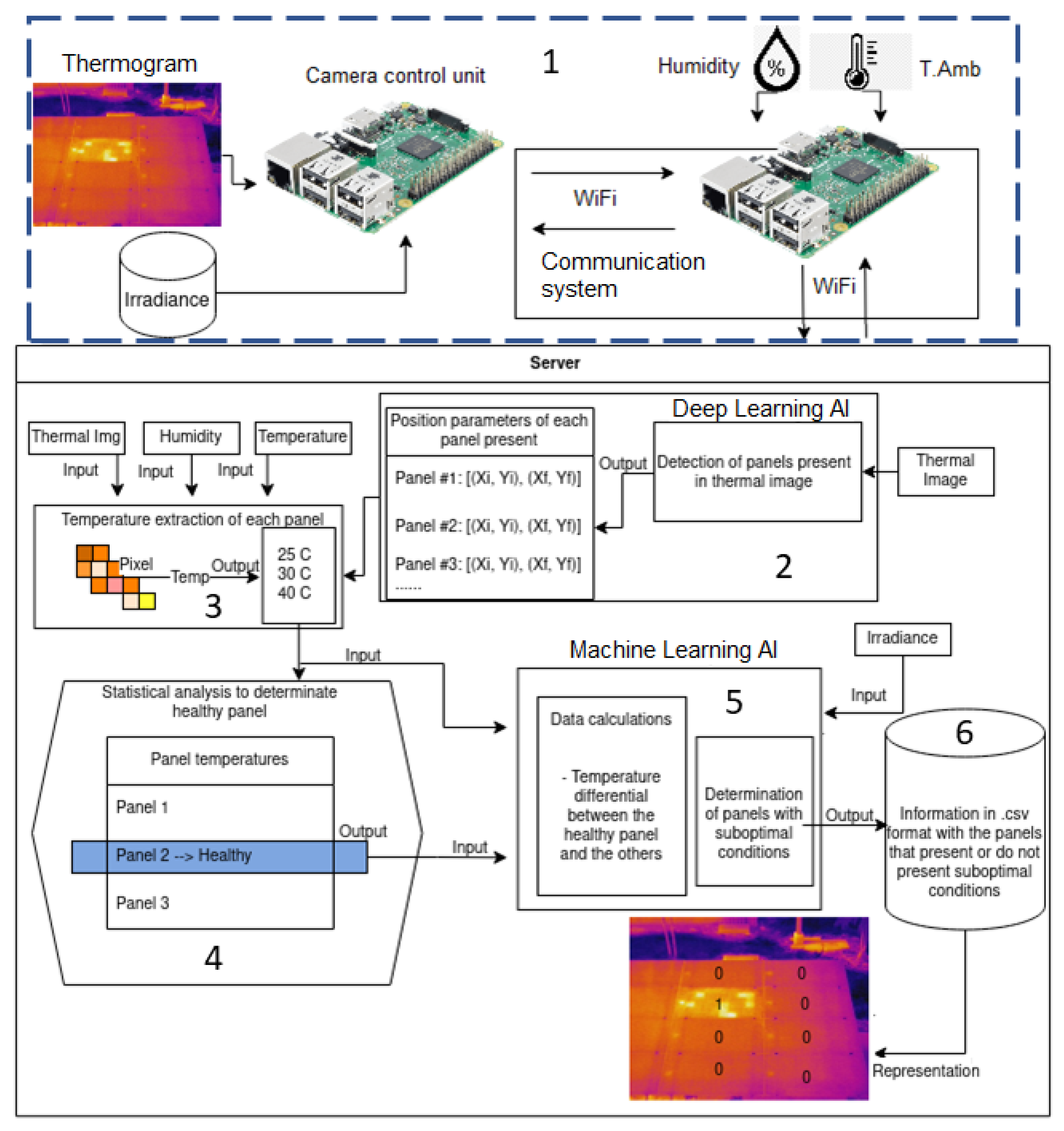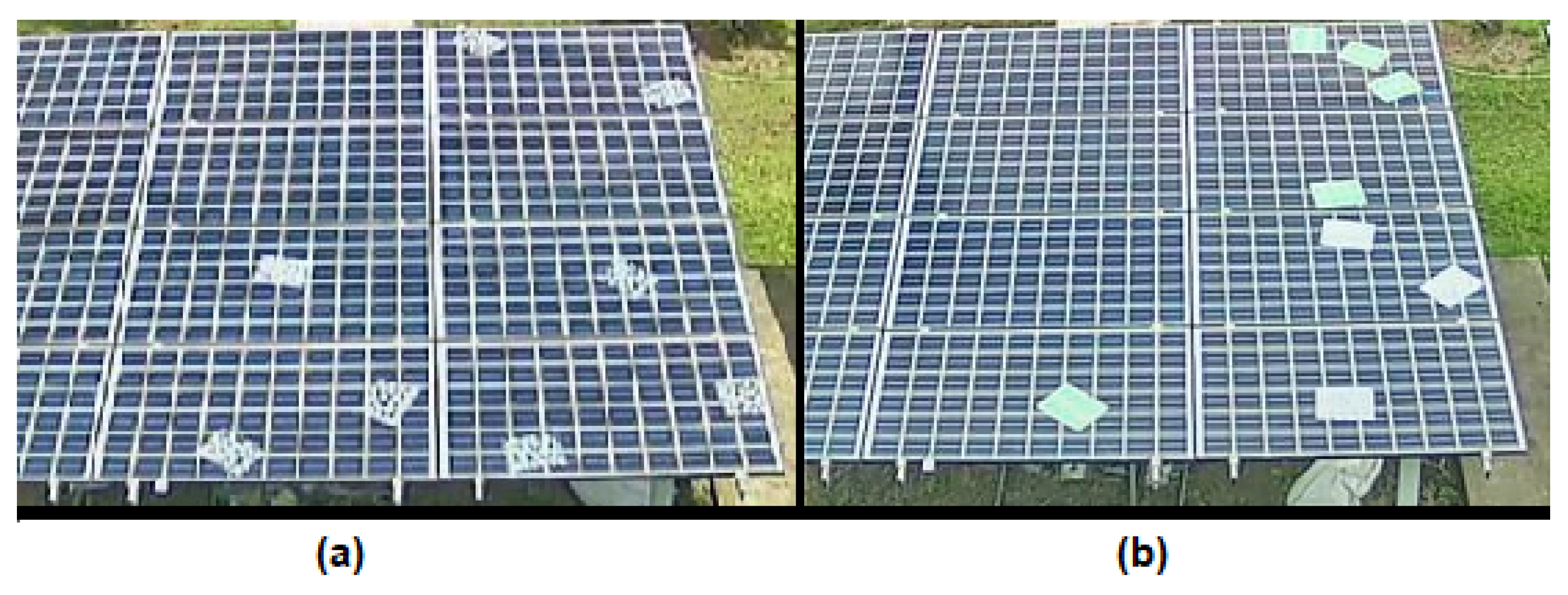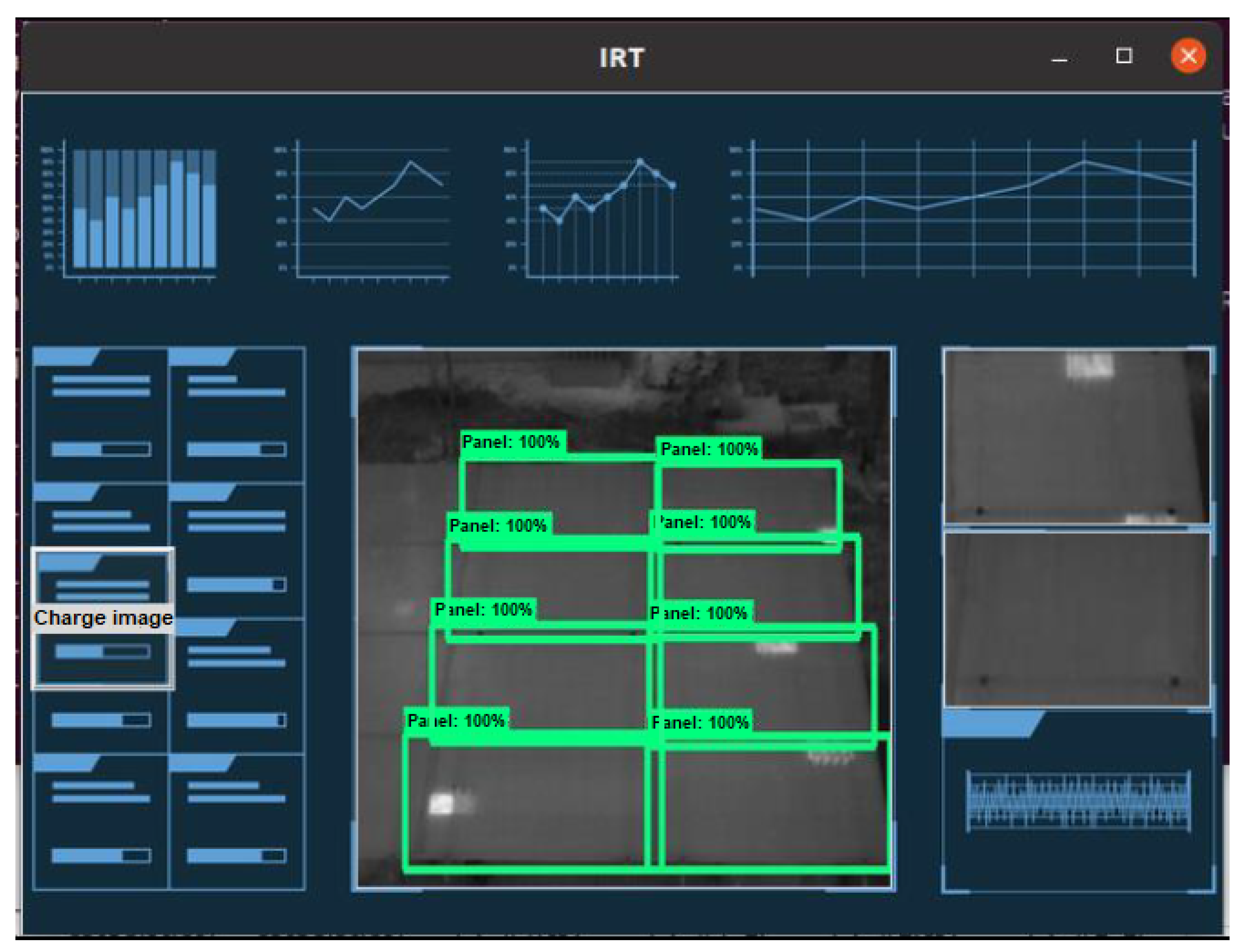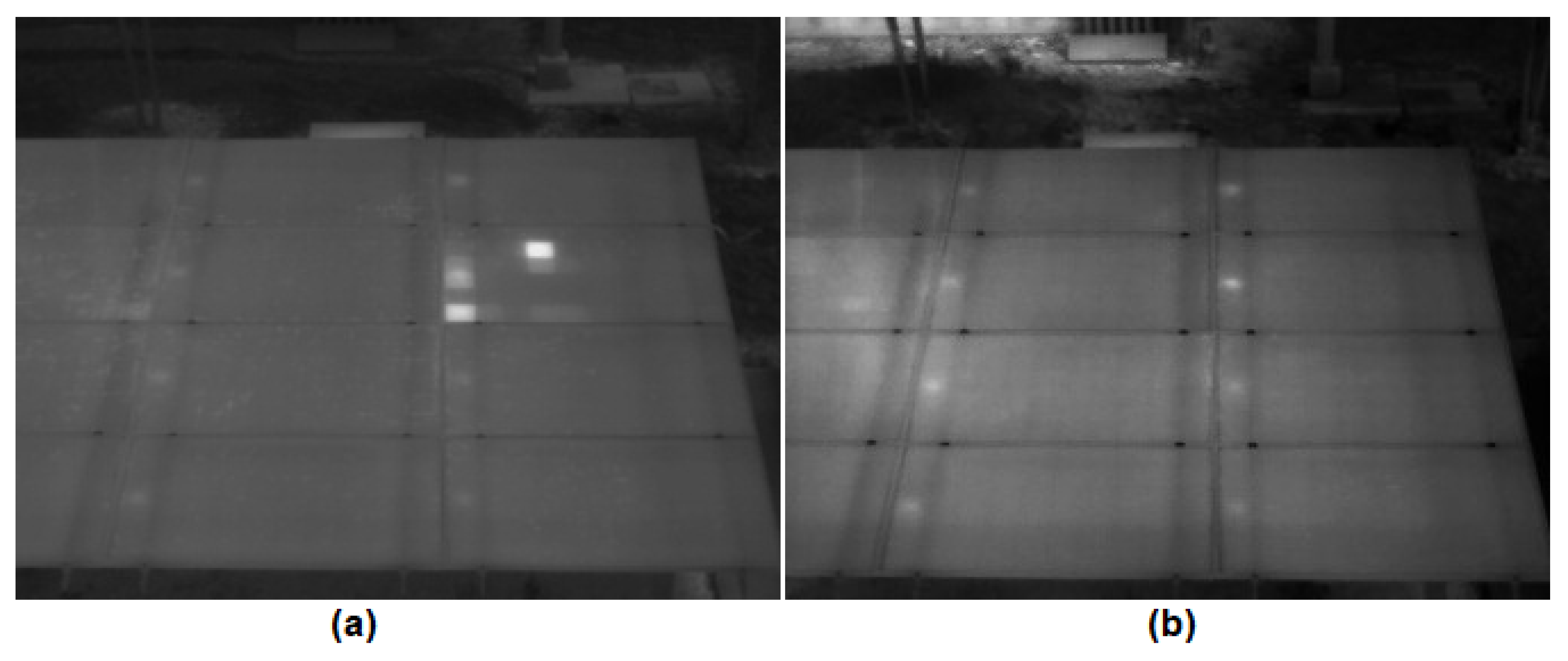IoT System Based on Artificial Intelligence for Hot Spot Detection in Photovoltaic Modules for a Wide Range of Irradiances
Abstract
1. Introduction
2. Related Work
2.1. IoT and Thermography
2.2. Deep Learning
2.3. Machine Learning
2.4. Innovation of This Work
3. Materials and Methods
3.1. PV System Analyzed
3.2. Data Acquisition System for Thermographic Analysis
3.3. System Requirements
- (a)
- Automatic and synchronous acquisition of all information needed for IRT analysis.
- (b)
- Automatic processing of the IRT data. The technique implicitly measures the temperature of each PV module by means of a model, details in [11].
- (c)
- The detection of hot spots in the modules should be automatic. For this purpose, the system verifies that there is at least an irradiance of 300 W/m.
- (d)
- Remote information management. The system can store information in data backup, with the possibility of accessing it online. Additionally, all system control is done via a graphical user interface (GUI).
3.4. Algorithm for Hot Spot Detection
3.5. Fault Detection Criteria
3.6. Deep Learning for Solar Module Recognition
3.7. Machine Learning for Hot Spot Detection
3.8. Validation Process
3.9. Limitations of the Project
4. Results and Discussion
4.1. Graphical Interface to Operate the System
4.2. Automatic Module Detection
4.3. Automatic Hot Spot Detection
4.4. Performance Evaluation
5. Conclusions
Author Contributions
Funding
Data Availability Statement
Acknowledgments
Conflicts of Interest
References
- Hoang, A.T.; Pham, V.V.; Nguyen, X.P. Integrating renewable sources into energy system for smart city as a sagacious strategy towards clean and sustainable process. J. Clean. Prod. 2021, 305, 127161. [Google Scholar] [CrossRef]
- Tsanakas, J.A.; Ha, L.; Buerhop, C. Faults and infrared thermographic diagnosis in operating c-Si photovoltaic modules: A review of research and future challenges. Renew. Sustain. Energy Rev. 2016, 62, 695–709. [Google Scholar] [CrossRef]
- Wu, Z.; Hu, Y.; Wen, J.X.; Zhou, F.; Ye, X. A Review for Solar Panel Fire Accident Prevention in Large-Scale PV Applications. IEEE Access 2020, 8, 132466–132480. [Google Scholar] [CrossRef]
- Lagüela, S.; Díaz-Vilariño, L.; Roca, D. Infrared Thermography: Fundamentals and Applications. In Non-Destructive Techniques for the Evaluation of Structures and Infrastructure, 1st ed.; Riveiro, B., Solla, M., Eds.; CRC Press: Boca Raton, FL, USA, 2016; Chapter 6; p. 26. [Google Scholar] [CrossRef]
- Cubukcu, M.; Akanalci, A. Real-time inspection and determination methods of faults on photovoltaic power systems by thermal imaging in Turkey. Renew. Energy 2020, 147, 1231–1238. [Google Scholar] [CrossRef]
- International Energy Agency. Review of Failures of Photovoltaic Modules; Technical Report July; International Energy Agency: Paris, France, 2014.
- International Energy Agency. Review on Infrared and Electroluminescence Imaging for PV Field Applications; Technical Report, Photovoltaic Power Systems Programme; International Energy Agency: Paris, France, 2018.
- Cardinale-Villalobos, L.; Meza, C.; Méndez-Porras, A.; Murillo-Soto, L.D. Quantitative Comparison of Infrared Thermography, Visual Inspection, and Electrical Analysis Techniques on Photovoltaic Modules: A Case Study. Energies 2022, 15, 1841. [Google Scholar] [CrossRef]
- Cardinale-Villalobos, L.; Meza, C.; Murillo-Soto, L.D. Experimental Comparison of Visual Inspection and Infrared Thermography for the Detection of Soling and Partial Shading in Photovoltaic Arrays. In Ibero-American Congress of Smart Cities; Springer International Publishing: Cham, Switzland, 2021; pp. 302–321. [Google Scholar] [CrossRef]
- Jiménez-Delgado, E.; Méndez-Porras, A.; Alfaro-Velasco, J. Generative Adversarial Network for Synthetic Imaging Data of Sub-optimal Conditions in Photovoltaic Panels. In International Conference on Information Technology & Systems; Springer International Publishing: Cham, Switzland, 2022; pp. 206–218. [Google Scholar] [CrossRef]
- Cardinale-Villalobos, L.; Solís-García, L.A.; Araya-Solano, L.A. IoT System for Thermographic Data Acquisition of Photovoltaic Installations. In Ibero-American Congress of Smart Cities; Springer International Publishing: Cham, Switzland, 2023; pp. 110–122. [Google Scholar] [CrossRef]
- Ali, M.U.; Khan, H.F.; Masud, M.; Kallu, K.D.; Zafar, A. A machine learning framework to identify the hotspot in photovoltaic module using infrared thermography. Sol. Energy 2020, 208, 643–651. [Google Scholar] [CrossRef]
- Tella, H.; Mohandes, M.; Liu, B.; Rehman, S.; Al-Shaikhi, A. Deep Learning System for Defect Classification of Solar Panel Cells. In Proceedings of the 2022 14th International Conference on Computational Intelligence and Communication Networks (CICN), Al-Khobar, Saudi Arabia, 4–6 December 2022; pp. 448–453. [Google Scholar] [CrossRef]
- Pham, D.A.; Le, A.D.; Pham, D.T.; Vo, H.B. AlertTrap: On Designing An Edge-Computing Remote Insect Monitoring System. In Proceedings of the 2021 8th NAFOSTED Conference on Information and Computer Science (NICS), Hanoi, Vietnam, 21–22 December 2021; pp. 323–328. [Google Scholar] [CrossRef]
- Subraja, N.; Venkatasekhar, D. Satellite Image Segmentation using Modified U-Net Convolutional Networks. In Proceedings of the 2022 International Conference on Sustainable Computing and Data Communication Systems (ICSCDS), Erode, India, 7–9 April 2022; pp. 1706–1713. [Google Scholar] [CrossRef]
- Haitao, C.; Caijia, L.; Xin, W.; Qiang, S. An automatic defects detection system for PV plants with data augmentation. In Proceedings of the 2021 International Conference on Power System Technology (POWERCON), Hangzhou, China, 8 December 2021; pp. 980–984. [Google Scholar] [CrossRef]
- Aghaei, M. Autonomous Monitoring and Analysis of Photovoltaic Systems. Energies 2022, 15, 5011. [Google Scholar]
- Madeti, S.R.; Singh, S. A comprehensive study on different types of faults and detection techniques for solar photovoltaic system. Sol. Energy 2017, 158, 161–185. [Google Scholar] [CrossRef]
- Alam, M.K.; Khan, F.; Johnson, J.; Flicker, J. A Comprehensive Review of Catastrophic Faults in PV Arrays: Types, Detection, and Mitigation Techniques. IEEE J. Photovoltaics 2015, 5, 982–997. [Google Scholar] [CrossRef]
- Phoolwani, U.K.; Sharma, T.; Singh, A.; Gawre, S.K. IoT Based Solar Panel Analysis using Thermal Imaging. In Proceedings of the 2020 IEEE International Students’ Conference on Electrical, Electronics and Computer Science (SCEECS), Online, 19–20 February 2022; pp. 1–5. [Google Scholar] [CrossRef]
- Salazar, A.; Macabebe, E.Q. Hotspots Detection in Photovoltaic Modules Using Infrared Thermography. MATEC Web Conf. 2016, 70, 10015. [Google Scholar] [CrossRef]
- Zefri, Y.; ElKettani, A.; Sebari, I.; Ait Lamallam, S. Thermal Infrared and Visual Inspection of Photovoltaic Installations by UAV Photogrammetry—Application Case: Morocco. Drones 2018, 2, 41. [Google Scholar] [CrossRef]
- Appiah, A.; Zhang, X.; Ayawli, B.; Kyeremeh, F. Review and Performance Evaluation of Photovoltaic Array Fault Detection and Diagnosis Techniques. Int. J. Photoenergy 2019, 2019, 6953530. [Google Scholar] [CrossRef]
- Mellit, A.; Tina, G.; Kalogirou, S. Fault detection and diagnosis methods for photovoltaic systems: A review. Renew. Sustain. Energy Rev. 2018, 91, 1–17. [Google Scholar] [CrossRef]
- Moretón, R.; Lorenzo, E.; Narvarte, L. Experimental observations on hot-spots and derived acceptance/rejection criteria. Sol. Energy 2015, 118, 28–40. [Google Scholar] [CrossRef]
- Golovko, V.; Kroshchanka, A.; Mikhno, E.; Komar, M.; Sachenko, A. Deep Convolutional Neural Network for Detection of Solar Panels. In Data-Centric Business and Applications: ICT Systems-Theory, Radio-Electronics, Information Technologies and Cybersecurity (Volume 5); Radivilova, T., Ageyev, D., Kryvinska, N., Eds.; Springer International Publishing: Cham, Switzland, 2021; pp. 371–389. [Google Scholar] [CrossRef]
- Golovko, V.; Bezobrazov, S.; Kroshchanka, A.; Sachenko, A.; Komar, M.; Karachka, A. Convolutional neural network based solar photovoltaic panel detection in satellite photos. In Proceedings of the 2017 9th IEEE International Conference on Intelligent Data Acquisition and Advanced Computing Systems: Technology and Applications (IDAACS), Bucharest, Romania, 21–23 September 2017; Volume 1, pp. 14–19. [Google Scholar] [CrossRef]
- Han, S.H.; Rahim, T.; Shin, S.Y. Detection of Faults in Solar Panels Using Deep Learning. In Proceedings of the 2021 International Conference on Electronics, Information, and Communication (ICEIC), Jeju, Republic of Korea, 31 January–3 February 2021; pp. 1–4. [Google Scholar] [CrossRef]
- Darapaneni, N.; Jagannathan, A.; Natarajan, V.; Swaminathan, G.V.; Subramanian, S.; Paduri, A.R. Semantic Segmentation of Solar PV Panels and Wind Turbines in Satellite Images Using U-Net. In Proceedings of the 2020 IEEE 15th International Conference on Industrial and Information Systems (ICIIS), Rupnagar, India, 26–28 November 2020; pp. 7–12. [Google Scholar] [CrossRef]
- Pierdicca, R.; Malinverni, E.S.; Piccinini, F.; Paolanti, M.; Felicetti, A.; Zingaretti, P. Deep Convolutional Neural Network for Automatic Detection of Damaged Photovoltaic Cells. Int. Arch. Photogramm. Remote. Sens. Spat. Inf. Sci. 2018, XLII-2, 893–900. [Google Scholar] [CrossRef]
- Dunderdale, C.; Brettenny, W.; Clohessy, C.; van Dyk, E.E. Photovoltaic defect classification through thermal infrared imaging using a machine learning approach. Prog. Photovoltaics Res. Appl. 2020, 28, 177–188. [Google Scholar] [CrossRef]
- Niazi, K.; Akhtar, W.; Khan, H.A.; Sohaib, S.; Nasir, A.K. Binary Classification of Defective Solar PV Modules Using Thermography. In Proceedings of the 2018 IEEE 7th World Conference on Photovoltaic Energy Conversion (WCPEC) (A Joint Conference of 45th IEEE PVSC, 28th PVSEC & 34th EU PVSEC), Waikoloa Village, HI, USA, 10–15 June 2018; pp. 0753–0757. [Google Scholar] [CrossRef]
- Vahidi, A.; Golkar, M.A. Fault Detection and Classification in PV Arrays Using Machine Learning Algorithms in the Presence of Noisy Data. In Proceedings of the 2022 9th Iranian Conference on Renewable Energy & Distributed Generation (ICREDG), Mashhad, Iran, 23–24 February 2022; pp. 1–7. [Google Scholar] [CrossRef]
- Tattersall, G.J. Infrared thermography: A non-invasive window into thermal physiology. Comp. Biochem. Physiol. Part A Mol. Integr. Physiol. 2016, 202, 78–98. [Google Scholar] [CrossRef]
- Fan, F.; Na, Z.; Zhang, C.; Li, H.; Tong, C. Hot Spot Detection of Photovoltaic Module Infrared Near-field Image based on Convolutional Neural Network. J. Phys. Conf. Ser. 2022, 2310, 012076. [Google Scholar] [CrossRef]
- Kurukuru, V.S.B.; Haque, A.; Tripathy, A.K.; Khan, M.A. Machine learning framework for photovoltaic module defect detection with infrared images. Int. J. Syst. Assur. Eng. Manag. 2022, 13, 1771–1787. [Google Scholar] [CrossRef]
- Tattersall, G.J. Thermimage: Thermal Image Analysis; R Package Version 4.1.3; R Core Team: Vienna, Austria, 2021. [Google Scholar] [CrossRef]
- Cardinale-Villalobos, L.; Rimolo-Donadio, R.; Meza, C. Solar panel failure detection by infrared UAS digital photogrammetry: A case study. Int. J. Renew. Energy Res. (IJRER) 2020, 10, 1154–1164. [Google Scholar]
- Krawczyk, B.; Schaefer, G. A pruned ensemble classifier for effective breast thermogram analysis. In Proceedings of the 2013 35th Annual International Conference of the IEEE Engineering in Medicine and Biology Society (EMBC), Osaka, Japan, 3–7 July 2013; pp. 7120–7123. [Google Scholar] [CrossRef]
- Pintea, S.; Moldovan, R. The Receiver-Operating Characteristic (ROC) analysis: Fundamentals and applications in clinical psychology. J. Cogn. Behav. Psychother. 2009, 9, 49–66. [Google Scholar]
- Maloca, P.M.; Lee, A.Y.; de Carvalho, E.R.; Okada, M.; Fasler, K.; Leung, I.; Hörmann, B.; Kaiser, P.; Suter, S.; Hasler, P.W.; et al. Validation of automated artificial intelligence segmentation of optical coherence tomography images. PLoS ONE 2019, 14, e0220063. [Google Scholar] [CrossRef] [PubMed]







| Parameter | Value |
|---|---|
| Array DC Power | 3.36 kW |
| Latitude | 10°32′ |
| Longitude | 84°31′ |
| PV modules model | Canadian Solar CS6k-280M |
| Inclination | 15° |
| Azimuth | 150° with respect to the North |
| Parameter | Value | Parameter | Value |
|---|---|---|---|
| HFOV × VFOV | 25° × 19° | Image width × height | 336 × 256 |
| Sensor (widht × height) | 5.764 mm × 4.351 mm | Accuracy | ±5 °C |
| Focal Lenght | 13.00 mm | Thermal sensitivity | 40 mK |
| Component | Parameter | Value |
|---|---|---|
| DHT11 Sensor | Temperature range | 0 °C to 50 °C |
| Humidity Range | 20% to 90% | |
| Accuracy | ±2 °C and ±5% | |
| Spektron 210 | Irradiance range | 0 to 1500 W/m |
| Accuracy | ±5% |
| Figure | Irradiance (W/m) | Module with Hot Spot Induced | Module with Hot Spot Detected | ||||||||||||||
|---|---|---|---|---|---|---|---|---|---|---|---|---|---|---|---|---|---|
| 1 | 2 | 3 | 4 | 5 | 6 | 7 | 8 | 1 | 2 | 3 | 4 | 5 | 6 | 7 | 8 | ||
| Figure 6a | 317 | 1 | 0 | 1 | 1 | 0 | 1 | 0 | 1 | 1 | 0 | 1 | 1 | 0 | 1 | 0 | 1 |
| Figure 6b | 430 | 1 | 0 | 0 | 0 | 0 | 0 | 0 | 0 | 1 | 0 | 0 | 0 | 0 | 0 | 0 | 0 |
| Figure 7a | 456 | 0 | 0 | 0 | 0 | 1 | 0 | 0 | 0 | 0 | 1 | 0 | 0 | 1 | 0 | 0 | 0 |
| Figure 7b | 362 | 0 | 0 | 0 | 0 | 0 | 0 | 0 | 0 | 1 | 0 | 0 | 0 | 0 | 0 | 0 | 0 |
| True | False | ∑ | |
|---|---|---|---|
| Positive | 216 | 18 | 234 |
| Negative | 437 | 1 | 438 |
| ∑ | 653 | 19 | 672 |
Disclaimer/Publisher’s Note: The statements, opinions and data contained in all publications are solely those of the individual author(s) and contributor(s) and not of MDPI and/or the editor(s). MDPI and/or the editor(s) disclaim responsibility for any injury to people or property resulting from any ideas, methods, instructions or products referred to in the content. |
© 2023 by the authors. Licensee MDPI, Basel, Switzerland. This article is an open access article distributed under the terms and conditions of the Creative Commons Attribution (CC BY) license (https://creativecommons.org/licenses/by/4.0/).
Share and Cite
Cardinale-Villalobos, L.; Jimenez-Delgado, E.; García-Ramírez, Y.; Araya-Solano, L.; Solís-García, L.A.; Méndez-Porras, A.; Alfaro-Velasco, J. IoT System Based on Artificial Intelligence for Hot Spot Detection in Photovoltaic Modules for a Wide Range of Irradiances. Sensors 2023, 23, 6749. https://doi.org/10.3390/s23156749
Cardinale-Villalobos L, Jimenez-Delgado E, García-Ramírez Y, Araya-Solano L, Solís-García LA, Méndez-Porras A, Alfaro-Velasco J. IoT System Based on Artificial Intelligence for Hot Spot Detection in Photovoltaic Modules for a Wide Range of Irradiances. Sensors. 2023; 23(15):6749. https://doi.org/10.3390/s23156749
Chicago/Turabian StyleCardinale-Villalobos, Leonardo, Efren Jimenez-Delgado, Yariel García-Ramírez, Luis Araya-Solano, Luis Antonio Solís-García, Abel Méndez-Porras, and Jorge Alfaro-Velasco. 2023. "IoT System Based on Artificial Intelligence for Hot Spot Detection in Photovoltaic Modules for a Wide Range of Irradiances" Sensors 23, no. 15: 6749. https://doi.org/10.3390/s23156749
APA StyleCardinale-Villalobos, L., Jimenez-Delgado, E., García-Ramírez, Y., Araya-Solano, L., Solís-García, L. A., Méndez-Porras, A., & Alfaro-Velasco, J. (2023). IoT System Based on Artificial Intelligence for Hot Spot Detection in Photovoltaic Modules for a Wide Range of Irradiances. Sensors, 23(15), 6749. https://doi.org/10.3390/s23156749







